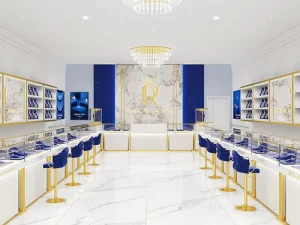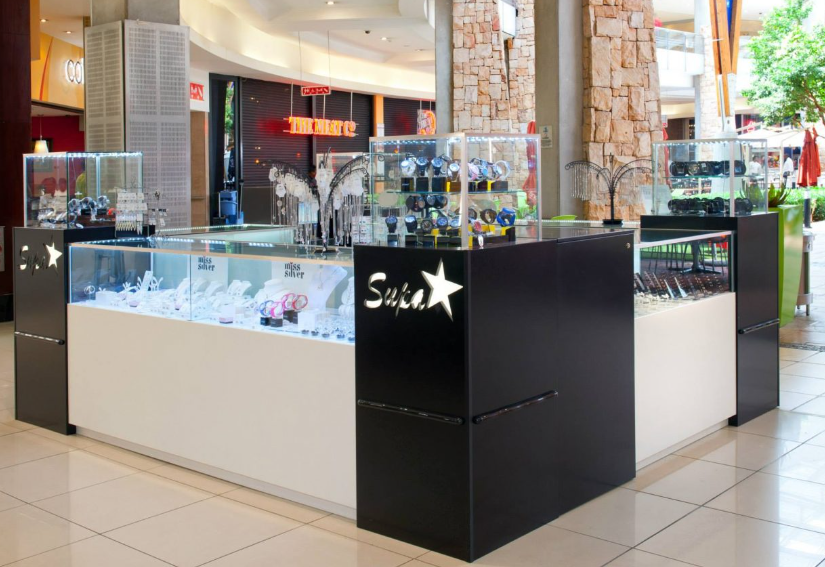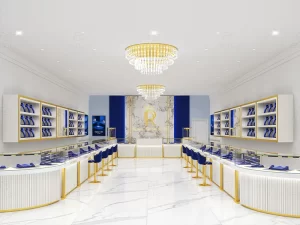

Blog Introduction:
Mall kiosks are small, independent retail units that can be found in shopping centers, airports, train stations, and other high-traffic locations. They offer a variety of products and services, from food and beverages to jewelry and electronics. For entrepreneurs and retailers looking to start or expand their businesses with low overhead costs, flexible leasing, and high exposure, mall kiosks are a popular choice.
But what trends will shape the mall kiosk industry in 2023? How can mall kiosk owners and operators adapt to the ever-changing customer expectations and preferences? In this article, we will explore the key trends in mall kiosks for 2023 and provide some tips and examples on how to succeed in this competitive market.
Store Fixtures Manufacturer
Over 24 years experience
Free Shop Design
Support 2D/3D custom design
I/E Trading
Market Cover 100+ Countries

1. Personalization Takes Center Stage
Personalization is no longer just a buzzword; it’s changing the game for retailers. In 2023, the focus will be on personalized shopping experiences. Leveraging artificial intelligence and machine learning, retailers can analyze customer data to create tailored shopping journeys. This leads to higher customer satisfaction, increased conversion rates, and stronger brand loyalty.
Data-Driven Personalization: According to a study by Salesforce, 62% of consumers expect companies to send personalized offers or discounts based on their previous purchase history.
Boosting Conversion Rates: Research by Epsilon shows that personalized email campaigns have an average open rate of 18.8%, compared to 13.1% for non-personalized emails.
2. Seamless Omnichannel Integration
In the current retail landscape, consumers expect a seamless transition between online and offline shopping. Retailers who can provide an integrated omnichannel experience are well-prepared for success. By connecting physical stores with e-commerce platforms, businesses can offer conveniences like in-store pickup, same-day delivery, and online-offline customer interactions.
Omnichannel Success: A report by Harvard Business Review states that companies with high omnichannel customer engagement saw a year-over-year revenue growth of 9.5%, while those with weak omnichannel engagement experienced a 3.4% revenue decline.
3. Augmented Reality (AR) Shopping
Augmented Reality (AR) is set to revolutionize how customers shop. From virtually trying on clothes to previewing furniture in their homes before purchasing, AR enhances the shopping experience. Retailers can harness the power of AR to not only engage customers but also reduce return rates by ensuring better alignment between expectations and reality.
AR Adoption: Statista predicts that the global AR user count will reach 1.96 billion by 2023.
Reduced Return Rates: The online home improvement platform Houzz reports that when AR tools are available, the number of products added to the creative book increased by 200%, leading to a reduction in return rates.
4. Sustainability and Ethical Shopping
Consumers are increasingly concerned about the environmental and ethical aspects of the products they purchase. Retailers adopting sustainable and ethical practices in their supply chains and product offerings resonate with a growing number of responsible consumers.
Impact of Sustainability: Nielsen research shows that 81% of global consumers strongly believe that companies should help improve the environment.
Consumer Preferences: A study by Kantar found that 52% of consumers make purchases based on a brand’s values and beliefs.
5. Voice Commerce and Smart Devices
The rise of voice assistants and smart devices has opened up new shopping avenues. Customers can now place orders and make inquiries through voice commands. Retailers who optimize their voice commerce websites and processes are venturing into this emerging market.
Voice Commerce Growth: eMarketer predicts that 9.7% of e-commerce sales in the United States in 2023, amounting to $376.3 billion, will be conducted through voice.
Adoption of Smart Speakers: According to Voicebot.ai, as of 2021, 26.2% of U.S. adults owned smart speakers, with this number steadily increasing.
6. Data Security and Privacy
With data breaches becoming more frequent, customers are concerned about the security of their personal information. Retailers prioritizing data security and privacy not only gain trust but also adhere to ever-evolving data protection regulations.
Data Breaches: The Identity Theft Resource Center recorded 1,298 data breach incidents in 2021, exposing over 750 million records.
Consumer Concerns: A survey by the Pew Research Center found that 79% of Americans worry about how companies use their data.
7. Social Commerce
Social media platforms are evolving as shopping destinations. Retailers can harness social commerce by integrating purchase buttons, creating shoppable posts, and fostering a sense of community around their brand.
Rise of Social Commerce: eMarketer predicts that social commerce sales in the United States will reach $366.2 billion in 2023, accounting for 4.3% of all e-commerce sales.
8. Instant Fulfillment
Customers expect instant fulfillment, and retailers are responding with faster delivery options, including same-day and one-hour delivery services. Providing these quick fulfillment choices can set your business apart.
Demand for Fast Delivery: A survey by PwC found that 88% of respondents are willing to pay for same-day or faster delivery.
Same-Day Delivery Providers: Companies like Amazon and Walmart are expanding their same-day delivery services to meet this demand.
9. Content-Driven Marketing
High-quality content is crucial for attracting and retaining customers. Retailers who invest in informative and engaging content, such as blogs, videos, and infographics, can establish authority and customer trust.
Effectiveness of Content Marketing: According to the Content Marketing Institute, 89% of B2B marketers and 86% of B2C marketers use content marketing, emphasizing its value in building brand authority and customer trust.
10. Customer Feedback and Improvement
Listening to customer feedback is more important than ever. Retailers should actively solicit customer opinions and use them to enhance products, services, and the overall shopping experience.
Importance of Customer Feedback: According to Qualtrics data, 77% of customers recommend a brand that responds to feedback.
Product Improvement: Salesforce research shows that 84% of customers say being treated as an individual, not just a number, is essential for winning their business.
How to Adapt to Mall Kiosk Trends in 2023
To adapt to the mall kiosk trends for 2023, mall kiosk owners and operators need to do the following:
Invest in technology. Technology is the key to delivering omnichannel, hyper-personalized, and experiential retail. Mall kiosk owners need to invest in the latest tools and devices that can enhance their customer experience, such as QR codes, NFC tags, Bluetooth beacons, mobile wallets, contactless cards, biometric authentication, 3D printers, AR and VR headsets, and CRM, AI, and ML software. They also need to ensure that their technology is compatible, secure, and reliable, and that they comply with the relevant regulations and standards.
Know your customers. Knowing your customers is essential to providing them with the best products and services that suit their needs, wants, and tastes. Mall kiosk owners need to collect and analyze customer data, such as demographics, preferences, behavior, and feedback, and use it to segment their customers, create buyer personas, and tailor their offers, recommendations, and communication. They also need to engage with their customers, listen to their feedback, and respond to their queries and complaints.
Be creative and innovative. Creativity and innovation are the driving forces behind the mall kiosk trends for 2023. Mall kiosk owners need to think outside the box and come up with new and exciting ways to attract and retain customers, such as offering personalized products, immersive experiences, and engaging stories, events, or activities. They also need to keep an eye on the market trends, customer preferences, and competitor strategies, and adapt accordingly

How to buy mall kiosk from China
Buying mall kiosks from China is a great way to save money and get high quality products. However, there are some things you need to consider before buying, such as
– Find a reliable and reputable mall kiosk manufacturer or supplier. You can use Google tools to find some of the top China shopping mall kiosk manufacturers or suppliers, you can view their websites, products, services and contact information, compare their prices, quality and reviews. You can also ask them for testimonials, samples or certificates to verify their credibility and professionalism.
– Choose the right mall kiosk design and specifications. You need to determine which type of mall kiosk you want, such as cell phone kiosk in mall, coffee kiosk, jewelry kiosk, eyeglasses kiosk or custom kiosk. You also need to determine the size, shape, style, color, material and features of the mall kiosk such as display, touch screen, payment system, lighting, signage and accessories. You can browse through some of the mall kiosk designs and specifications on the manufacturer’s or supplier’s website, or you can request for a customized design to suit your needs and preferences.
– Negotiate the best deal and terms. You need to negotiate with the manufacturer or supplier on the price, payment method, delivery time, shipping cost, warranty and after-sales service. You need to make sure you get your money’s worth and sign a clear written contract covering all the details and conditions of the purchase. You also need to understand the import and export regulations, taxes, duties and customs clearance procedures in China and your country, and make sure you comply with them.
– Inspect and test the mall kiosk before acceptance. Before taking delivery of the mall kiosk, you need to inspect and test it to ensure that it meets your order and expectations. You will need to inspect the quality, functionality, appearance and safety of the mall kiosk and report any defects, damage or errors to the manufacturer or supplier. If necessary, you need to request a repair, replacement or refund and make sure you have proof of delivery and a receipt.
Share:
Shop Fixtures Manufacturer
We are a manufacturer of display products established in 1995 in Guangzhou, China. We specialize in a wide range of retail store fixtures,including display case,showcase,racks,counters,stands , etc. Providing customers with one-stop merchandising solutions.
Recent Posts
Subscribe to Newsletter
Get all the latest information on shop design ideas, sales and offers. Subscribe to the newsletter:
Subscribe to Newsletter
Get all the latest information on shop design ideas, sales and offers. Subscribe to the newsletter:

